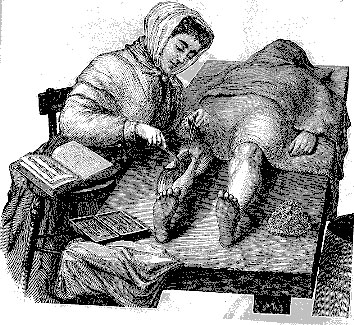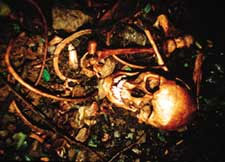
| 
| 
drawing by E. Paul Catts*
This is the Fourth of June
Think not I never dream
The noise of that infernal noon,
The stretchers' endless stream,
The tales of triumph won,
The night that found them lies,
The wounded wailing in the sun,
The dead, the dust, the flies.
The flies! oh God, the flies
That soiled the sacred dead.
To see them swarm from dead men's eyes
And share the soldiers' bread!
Nor think I now forget
The filth and stench of war,
The corpses on the parapet,
The maggots in the floor.
-A. P. Herbert (Title unknown)



What a BARGAIN!!! You better act fast because this is going to go quick! | 
| 
| 
| 
| 
| What is Forensic Entomolgy?
Forensic entomology is the study of arthropods, used to solve matters of legal interest, most often of a criminal nature. It's mostly a repeated tale of human tragedy combined with some remarkable insect ecology. 
Forensic entomology is a field that is for the strong of stomach and weak of nose. It takes time to get used to it. Requirements: A PhD and a Strong Stomach
Training for forensic entomology is eclectic.
Certification requires a doctorate in medical entomology with research and case investigation experience in forensics. Solid backgrounds in insect taxonomy and natural history, as well as comprehension of accepted standards of crime scene investigation and evidence handling, are important too. Training in ecology is crucial, as a rotting corpse is in essence an ecosystem, with the diners' comings and goings a classic example of succession.
But see, amid the mimc rout,
A crawling shape intrude !
A blood-red thing that writhes from out
The scenic solitude
It writhes ! - It writhes ! -
with mortal pangs
The mimes become its food
And the seraph sob at vermin fangs
In human gore imbued
Edgar Allan poe
"Conqueror Worm"
Please sign my guestbook with any comments or reactions you have to my site. You can also contact me privately at tammyrudisil@hotmail.com
Read my Dreambook guestbook!
Sign my Dreambook! |  | ![[Aaddzz Counter]](http://counter.aaddzz.com/counter.cgi?id=114531)
| 
| 
| 
| 
| 
| Early recordings of Forensic Entomology
The application of insect evidence to criminal investigations is not a new idea. A form of forensic entomology was practiced at least as early as the thirteenth century. In 1235 a Chinese "death investigator" named Sung Ts'u wrote a book entitled The Washing Away of Wrongs.
Not until several centuries later, in 1668, was the link between fly eggs and maggots discovered in the West. Before then, people did not realize that maggots hatched from the eggs flies laid on exposed meat or decomposing bodies
The first record of the use of insects in a forensic investigation in the West dates from 1855. During a remodeling of a house outside Paris, the mummified body of an infant was discovered behind a mantelpiece. Suspicion soon centered on the young couple then occupying the house. An autopsy was performed on the infant by Dr. Bergeret d'Arbois of nearby Jura, Switzerland, who concluded that the child had died in 1848. He noted evidence that a flesh fly, Sarcophaga canaria, had exploited the body during the first year (1848) and that mites had laid their eggs on the dried corpse the following year (1849). Bergeret's analysis of the insect evidence demonstrated to the satisfaction of the police that the death had occurred much earlier than 1855 and that the logical suspects were the occupants of the house in 1848, and they were subsequently arrested and convicted of the murder. | 
| 
|

